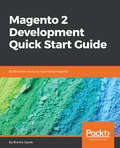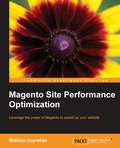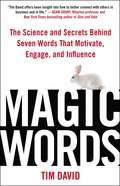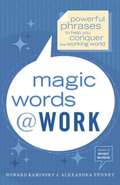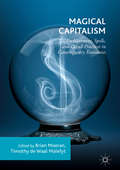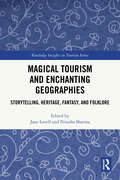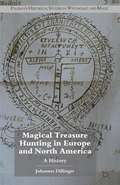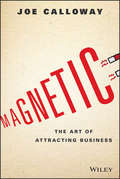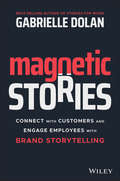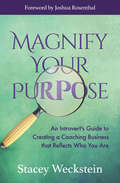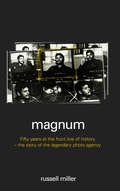- Table View
- List View
Magento 1.3: PHP Developer's Guide
by Jamie HuskissonThis book is a practical tutorial, filled with examples, aimed at people with no experience of programming web sites using the Magento system. If you are a PHP developer who wants to understand the architecture of Magento, learn how to extend the system with PHP code, add new features, and integrate Magento with a third-party CMS, this book is for you. You are expected to be a confident PHP 5 developer. No experience of Magento development is expected, although you should be familiar with the operation of Magento. No experience of the Zend framework is expected.
Magento 2 Cookbook
by Ray Bogman Vladimir KerkhoffOver 50 practical recipes that will help you realize the full potential of Magento in order to build a professional online store About This Book * Take advantage of the latest features in Magento 2 to set up an e-commerce store that fits your business needs * Packed with several advanced recipes, not just to manage your online store, but to extend and design it as well * Written in a cookbook style, you can pick and choose your recipe to carry out your day- to- day Magento store tasks Who This Book Is For The book is for existing Magento users who want to gain further expertise and insights into managing, designing, and extending their online store in Magento to fit their business needs. Working knowledge of Magento and basic familiarity with programming is expected. What You Will Learn * Set up a Magento 2 project on Apache or Nginx. * Transfer your Magento 1 database to Magento 2 using the Magento 2 system tools. * Boost the performance of Magento 2 by enabling different types of caching. * Build a Magento 2 multi-store by creating a root catalog, subdirectories, and products. * Create and manage pages, blocks, and front-end apps. * Manage your Magento store by setting up the correct TAX rules. * Design custom themes within the Magento 2 framework. * Create basic and advanced extensions using Magento 2. In Detail Magento 2 is an open source e-commerce platform that has all the functionality to function from small to large online stores. It is preferred by developers and merchants due to its new architecture, which makes it possible to extend the functionalities with plugins, a lot of which are now created by the community. This merchant and developer guide is packed with recipes that cover all aspects of Magento 2. The recipes start with simple how-to's then delve into more advanced topics as the book progresses. We start with the basics of setting up a Magento 2 project on Apache or Nginx. Next, you will learn about basics including system tools and caching to get your Magento 2 system ready for the real work. We move on to simple tasks such as managing your store and catalog configuration. When you are familiar with this, we cover more complex features such as module and extension development. Then we will jump to the final part: advanced Magento 2 extensions. By the end of this book, you'll be competent with all the development phases of Magento 2 and its most common elements. Style and approach Step by step guide for real world tasks for Magento users to gain a more advanced insight on managing, extending and designing their e-commerce store to fit their business needs.
Magento 2 Development Quick Start Guide: Build better stores by extending Magento
by Branko AjzeleCreate an interactive online store and customize it further using MagentoKey FeaturesStraightforward guide to developing with MagentoExamples of different types of extensionCustomize the Magento storefront and admin areasBook DescriptionMagento is an open source, enterprise-level e-commerce platform with unlimited scope for customization. This makes it a great choice not only for vendors, but for developers as well.This book guides you through Magento development, teaching you how to develop modules that extend or change its functionality, leading to more flexible and proftable Magento stores. You start with a structural overview of the key Magento development components.You will learn where things such as plugins, events, models, controllers, layouts, and UI components ft into the development landscape. You will go through examples of using these components to extend Magento. As you progress, you will be building a diverse series of small but practical Magento modules.By the end of this book, you will not only have a solid foundation in the Magento development architecture; you will also have practical experience of developing modules to customize and extend Magento stores.What you will learnDevelop a simple shipping moduleBuild admin interfaces with the built-in form and listing UI componentsImplement JavaScript components for improved customer experienceAccommodate vendor needs by adding new catalog-related featuresDevelop your way to a better checkoutImprove customer interaction with new customer-related extensionsCreate new web APIs to make your modules more extensibleWho this book is forThis book is for competent PHP developers, with only basic knowledge of the Magento platform required.
Magento Mobile How-to
by Darko GolesFollow the creation of a sample Magento Mobile application with plenty of screenshots and practical examples to guide you along the way. This book is great for Magento store owners and administrators that want to expand their business to mobile platforms with minimal investment. Also this is an irreplaceable manual for Magento developers when configuring Magento Mobile applications for clients.
Magento PHP Developer’s Guide
by Allan MacgregorMagento PHP Developer's Guide is an easily accessible tutorial, designed and written to give the reader maximum understanding of the powerful Magento framework. This book is written for developers who have previous experience with PHP and PHP frameworks, such as Zend or CakePHP, and want to start developing and working with Magento. Even developers with previous experience with Magento will find the book extremely useful to gain a full understanding of Magento fundamentals, architecture, and overall philosophy.
Magento Site Performance Optimization
by Mathieu NayrollesMagento Site Performance Optimization follows a handson, easytofollow approach, which focuses on the optimization of Magento's performance. Each chapter has a very logical flow, which makes the book readerfriendly. This book is written for Magento administrators who wish to optimize their store to increase performance, without spending thousands of dollars a year for the enterprise edition of Magento. It is noteworthy that Magento, as a project, comes with a gigantic code base and tools; however, the reader needs to be up for the challenge, ready to produce their own code to make the most of its code base.
Maggie Wilderotter: The Evolution of an Executive
by Boris Groysberg Sarah L. Abbott Robin AbrahamsIn a career that spanned over 30 years, Maggie Wilderotter served as CEO of two publicly traded companies and served on 32 corporate and nine association and non-profit boards of directors. As CEO of Frontier Communications, a U.S. telecom company with over $25 billion in assets, Wilderotter executed three major acquisitions, transforming the company's business mix and more than doubling its size. This case explores Wilderotter's career, examining the personal characteristics that made her such a successful executive and board member. The case also looks at the turning points in Wilderotter's career; the decisions she made and the way in which she built her skills.
Magic Bus: From Childhood to Livelihood
by V. Kasturi Rangan Anjali Raina Rachna Chawla Vikram GandhiCase
Magic Words
by Jonah BergerA NEXT BIG IDEA CLUB 'MUST-READ'New York Times bestselling author Jonah Berger’s cutting-edge research reveals how six types of words can increase your impact in every area of life: from persuading others and building stronger relationships, to boosting creativity and motivating teams.Almost everything we do involves words. Words are how we persuade, communicate, and connect. They’re how leaders lead, salespeople sell, and parents parent. They’re how teachers teach, policymakers govern, and doctors explain. Even our private thoughts rely on language.But certain words are more impactful than others. They’re better at changing minds, engaging audiences, and driving action. What are these magic words, and how can we take advantage of their power?In Magic Words, internationally bestselling author Jonah Berger gives you an inside look at the new science of language and how you can use it. Technological advances in machine learning, computational linguistics, and natural language processing, combined with the digitization of everything from cover letters to conversations, have yielded unprecedented insights.Learn how salespeople convince clients, lawyers persuade juries, and storytellers captivate audiences; how teachers get kids to help and service representatives increase customer satisfaction; how startup founders secure funding, musicians make hits, and psychologists identified a Shakespearean manuscript without ever reading a play.This book is designed for anyone who wants to increase their impact. It provides a powerful toolkit and actionable techniques that can lead to extraordinary results. Whether you’re trying to persuade a client, motivate a team, or get a whole organization to see things differently, this book will show you how to leverage the power of magic words.
Magic Words
by Tim DavidYears of experience as a magician taught Tim David that real magic is all about words, and the way they influence the minds of the audience. What sets a professional magician apart from an amateur are people skills like communication, influence, and engagement--skills that are also effective in the workplace. By applying seven "magic" words in a business setting, David offers tools for effective and persuasive communication. You will learn: The secret word that Harvard psychologists discovered is the key to unlocking human motivation How one very special word (spoken only inside your mind) mysteriously has a profound positive impact on those around you The number one mistake that managers make during 1-on-1's, and the one simple word that can fix it all What Dale Carnegie dubs "the sweetest sound in any language" How one tiny word can instantly change someone's mind for the better The single word that an in-depth study of thousands of hours of call center recordings revealed as the quickest way to reduce differences and calm people down How the infamous "But Eraser" works and why so many people mess it up The REAL magic behind the word "thanks" The seven words: Magic Word #1 - Because Magic Word #2 - "Name" Magic Word #3 - If Magic Word #4 - But Magic Word #5 - Absolutely Magic Word #6 - Thanks Magic Word #7 - Help
Magic Words at Work: Powerful Phrases to Help You Conquer the Working World
by Howard Kaminsky Alexandra PenneyFrom the bestselling authors of Magic Words: a collection of workplace wisdom for spectacular results on the jobHaving survived and thrived in the competitive media industry, Alexandra Penney and Howard Kaminsky are now revealing their strategies for success. Magic Words at Work captures lessions learned in the trenches and coins perfect turns of phrase for every office situation, including:• Raising Your Voice Can Work Better Than Raising Your Hand: Don’t spend your life asking for permission and waiting to be called on• The Red Light Is On: Learn the secret to working without interruption • Make Like a Prairie Dog: When management is in flux, stay low to the ground• I'm Going to Lead Between the Lines: Find a solution, then make it fit the rules • Low Overhead Equals High Independence: Living debt-free keeps your options wide openWith a memorable mixture of chutzpah and charm, Kaminsky and Penney deliver the bottom line on rising to the top.
Magical Capitalism: Enchantment, Spells, and Occult Practices in Contemporary Economies
by Brian Moeran Timothy de Waal MalefytThis volume of essays examines the ways in which magical practices are found in different aspects of contemporary capitalist societies. From contract law to science, by way of finance, business, marketing, advertising, cultural production, and the political economy in general, each chapter argues that the kind of magic studied by anthropologists in less developed societies – shamanism, sorcery, enchantment, the occult – is not only alive and well, but flourishing in the midst of so-called ‘modernity’. Modern day magicians range from fashion designers and architects to Donald Trump and George Soros. Magical rites take place in the form of political summits, the transformation of products into brands through advertising campaigns, and the biannual fashion collections shown in New York, London, Milan and Paris. Magical language, in the form of magical spells, is used by everyone, from media to marketers and all others devoted to the art of ‘spin’.While magic may appear to be opposed to systems of rational economic thought, Moeran and Malefyt highlight the ways it may in fact be an accomplice to it.
Magical Tourism and Enchanting Geographies: Storytelling, Heritage, Fantasy, and Folklore (Routledge Insights in Tourism Series)
by Jane Lovell Nitasha SharmaThis book explores the events, attractions, and places that comprise magical tourism. It showcases magical storytelling, ecologies, realities, entities, belief systems, cultural heritage, and rituals leading to spiritual, otherworldly, enchanting, mindful, interconnected, green, and dark experiences.The volume offers the reader insights into the exciting, popular new tourism trend of magical tourism and its over-arching attributes and tropes. Chapters feature a number of case studies and discussions including the history of magical travel, studies of affect, witch festivals, the rights of mythical animals, folkloric beasts, unmappable places that seem to retreat and slide sideways, multi-layered place folklore and mythology, portals, nexuses of meaning, fayres, festivals, identities, and cos-play. This volume addresses the challenges of sustainable futures, green heritages, commercialisation, representation, inclusion, accessibility, community ownership, magical events, beliefs, and practices and asks if there is a magical turn in research.The book is highly relevant to those with expertise and interest in geography, tourism, hospitality and events studies, marketing, religious studies, anthropology, sociology, and heritage and cultural studies.
Magical Treasure Hunting in Europe and North America
by Johannes DillingerThe first comprehensive history of magical treasure hunting from the Middle Ages to the 20th century, revealing a magical universe of treasure spirits, and wizards who tried to deal with them. Combining history and anthropology, this study sees treasure hunting as an expression of shifting economic mentalities and changing ideas about history.
Magnetic
by Joe CallowayMagnetic: The Art of Attracting Business is a look at how consistently successful businesses are able to attract a steady and ever-increasing flow of customers. This innovative text examines a range of simple, powerful strategies that businesses of any size or type can use to attract new customers. The key is to do those things that harness the power of the single most important factor in buying decisions: positive word of mouth and referrals from happy existing customers. Magnetic businesses are intentional, strategic, and focused on creating positive experiences that become the stories their customers tell about them. Whether on the internet or face to face, it's what satisfied customers say about you that is the most powerful driver of growth for your business. Becoming Magnetic and attracting business, truly is an art, rather than a science, because every business is different, and uses a unique combination of strategy, people, and purpose to achieve success and growth. There is no one-size-fits-all formula, but with creativity and focus, any business can create a powerful revenue growth engine that continuously works to build and sustain success. Learn how to match successful growth strategies with your people, purpose, and culture to create your own unique 'magnetism' to attract business. Discover the simple, powerful keys to growth used by a range of market leading businesses, from a snowboard manufacturing startup company and a website design professional to a minor league baseball team and an family owned upscale grocery store. All of them utilize ideas that you can put to work immediately in your business to become Magnetic. Create a magnetic mindset in your people that leads not only to happier customers who refer others to you, but to more satisfied employees who help attract and recruit great new employees to keep your momentum going. Simplify and clarify how you think about your business to have your entire team become more focused, efficient, and effective in doing those few vitally important things that matters most in driving growth and sustaining success.
Magnetic Sponsoring
by Mike DillardMagnetic Sponsoring is unlike anything you've ever seen or read before when it comes to building a network marketing or MLM business.
Magnetic Stories: Connect with Customers and Engage Employees with Brand Storytelling
by Gabrielle DolanTake control of your brand and your stories for greater success Your brand is the stories people share about you when you're not in the room, and it's these brand stories that determine if people buy from you, employ you, work for you or invest in you. When the stakes are that high, wouldn't you want to take control of it? In Magnetic Stories, business storytelling expert Gabrielle Dolan reveals how you too can create and share stories that stick. Learn how to: define and distinguish your brand stand out from the competition implement brand storytelling effectively strengthen your presence online by sharing magnetic stories make your employees and customers your greatest advocates. In a world of inauthentic brands, Magnetic Stories is a must read for anyone who wants their brand to be relatable, believable and to create long-term brand loyalty.
Magnify Your Purpose: An Introvert's Guide to Creating a Coaching Business that Reflects Who You Are
by Stacey WecksteinDo what you love and you&’ll never work a day in your life—and with the help of this inspiring self-help guide, you can do just that! What&’s holding you back from doing what you love? Do you want to create a business that reflects who you are? And stop feeling guilty about what others think you &“should&” do with your life? In Magnify Your Purpose, creative business coach Stacey Weckstein, founder of Radiant Mind and Body LLC, will help you find your inner voice and the confidence to bring your authentic self out into the world. She will help you navigate around the pitfalls where too many creative professionals and new coaches get stuck trying to fit into traditional ways of doing business. Best of all, she will teach you―as she has taught herself and many others―how to turn your passions into a purposeful career. Join Stacey on the journey of reconnecting with yourself and manifesting your dreams.
Magnum: Fifty Years at the Front Line of History
by Russell MillerThis book is a biography of Magnum, told largely in the words of its photographers. It offers a unique perspective on half a century of world history from an extraordinary group of men and women who were front line witnesses at virtually every major event in the last fifty years. Wars, famines, natural disasters, social, political and environmental crises - Magnum photographers were there. They have been acute observers of the human condition, photographing the richest people in the world, the poorest, the least known and the most celebrated, from Marilyn Monroe to Che Guevara, JFK to Nelson Mandela, Picasso to Krushchev. This is a multi-layered story. At one level, it tells how a small group of photographrs - among them Robert Capa, Henri Cartier-Bresson and George Rodger - came together, established and nurtured a co-operative photographic agency that has survived against all the odds to become the most famous in the world. At a secondary level, it is the richly anecdotal story of the photographers themselves, their adventures around the world and their feelings about, and reactions to, their assignments.
Magnus Resch: Transforming the Art Market Through Transparency
by Sarah Mehta Henry W. McGeeEconomist and entrepreneur Magnus Resch was on a mission to make the art market more transparent. To that end, in 2014, he began building the Magnus app, which catalogued the price and transaction history of millions of works of art. Users could download the app, take a photo of any flat artwork, and the app would display that piece's price along with other pertinent information. Resch believed that such radical transparency would grow the small, rather insular, network of serious art collectors. By May 2018, the app had garnered strong user engagement, with over 10,000 new downloads per month. But Resch was not yet generating revenue from the Magnus app, which was free for users to download. The case explores Resch's options for monetizing the app, as well as the benefits and drawbacks of each option.
Magpie: Developing and Using Buyer Personas
by Frank V. CespedesThe founders of a start-up platform for publishers have developed preliminary personas of target customers, and are evaluating the implications for initial target buyers, messaging, and marketing programs.
Mahindra & Mahindra: Creating Scorpio
by Tarun Khanna Rajiv Lal Merlina ManocaranDetails the emergence of a private sector automobile manufacturer in India that has created globally competitive and cheap versions of an SUV commonly available worldwide. Asks us to think about the parent corporation's next steps in leveraging this success. In particular: To what extent does it make sense to expand overseas vs. entrenching itself within the home market--India?
Mahindra & Mahindra: Leveraging India's Size for Global Scale in Tractors--A Profile of One of India's Pioneering Multinationals
by Nirmalya Kumar Pradipta K. Mohapatra Suj ChandrasekharMahindra & Mahindra started in 1945 at the dawn of Indian independence and has since transformed from a steel trader, to an assembler of Jeeps from kits imported from the U.S., to a multifaceted business with a global presence in eight key sectors and global revenue in 2008 of $6.7 billion. This chapter focuses on M&M's two largest businesses--automotive and farm equipment, tracing the company's sometimes rocky journey to becoming a global powerhouse. This chapter is excerpted from "India's Global Powerhouses: How They Are Taking on the World."
Mahindra Lifespace Developers' Venture into Affordable Housing
by Joseph Fuller Vidhya MuthuramCase
Maid to Order in Hong Kong: Stories of Migrant Workers, Second Edition
by Nicole ConstableMiddle-class Chinese women in the global city of Hong Kong have entered the workforce in unprecedented numbers over the past three decades, and the demand for foreign domestic workers has soared. A decade ago some foretold the decline in foreign workers and the influx of mainland workers. But today over 120,000 women from the Philippines, over 90,000 from Indonesia, and thousands more from other parts of South and Southeast Asia serve as maids on two-year contracts in Hong Kong, sending much needed remittances to their families abroad. Nicole Constable tells their story by updating Maid to Order in Hong Kong with a focus on the major changes that have taken place since Hong Kong's reunification with mainland China in 1997, the Asian financial crisis of the late 1990s, and the outbreak of SARS in 2002-2003. Interweaving her analysis with the women's individual stories, she shows how power is expressed in the day-to-day lives of Filipina domestic workers and more-recent Indonesian arrivals.


